Contextualization, Procedural Logic, and Active Construction: A Cognitive Scaffolding Model for Topic Sentiment Analysis in Game-Based Learning
Abstract
1. Introduction
2. Research Design and Methodology
3. Methodology
3.1. Platform Selection and Data Processing
3.2. Sentiment Analysis
3.3. Topic Modeling
3.4. Topic Sentimen
4. Results
4.1. Sentimental Attitude
4.1.1. Keyword Analysis
4.1.2. Sentimental Score Analysis
4.1.3. Sentimental Attitude Analysis
4.2. Potential Topic Analysis
4.3. Topic Sentiment Analysis
5. Discussion and Contribution
5.1. Discussion of Sentimen Based on Topic Modeling
5.1.1. Contextualized Learning: Stimulating Intrinsic Motivation and Strengthening Autonomous Interaction in Logical Thinking
5.1.2. Cognitive Deepening: The Cycle of Progressive Logical Thinking and Teaching Innovation
5.1.3. Dynamic Support and Gradual Capability Enhancement Mechanism of Cognitive Scaffolding in Gamified Education
5.2. Research Contributions and Inspiration
5.2.1. The Main Contributions of This Study Are as Follows
5.2.2. Practical Recommendations
6. Conclusions
Author Contributions
Funding
Institutional Review Board Statement
Informed Consent Statement
Data Availability Statement
Conflicts of Interest
References
- Alkurdi, S. (2021). Gamification in knowledge management: Increasing motivation to share knowledge using cooperation and inter-team competition [Doctoral dissertation, The Claremont Graduate University]. [Google Scholar]
- Al Mamun, M. A., & Lawrie, G. (2024). Cognitive presence in learner–content interaction process: The role of scaffolding in online self-regulated learning environments. Journal of Computers in Education, 11(3), 791–821. [Google Scholar] [CrossRef]
- Alvear, H., Arias-Flores, H., Ramos-Galarza, C., & Jadán-Guerrero, J. (2021). Introducing gamification in professional training. In Artificial intelligence, computer and software engineering advances: Proceedings of the CIT 2020 volume 1. Springer. [Google Scholar]
- Alzahrani, F. K. J., & Alhalafawy, W. S. (2022). Benefits and challenges of using gamification across distance learning platforms at higher education: A systematic review of research studies published during the COVID-19 pandemic. Journal of Positive School Psychology, 6(10), 1948–1977. [Google Scholar]
- Aryulina, D. (2020). Implementing immediate feedback with unlimited plus bonus points to increase college student learning motivation and achievement. International Journal of Instruction, 13(3), 387–400. [Google Scholar] [CrossRef]
- Azadnia, M. (2024). ChatGPT-assisted language learning and teaching: A scoping review of research on ChatGPT use in L2 pedagogy and education. Teaching English as a Second Language Quarterly (Formerly Journal of Teaching Language Skills), 43(2), 49–85. [Google Scholar]
- Beck, D., Morgado, L., & O’Shea, P. (2023). Educational practices and strategies with immersive learning environments: Mapping of reviews for using the metaverse. IEEE Transactions On Learning Technologies, 17, 319–341. [Google Scholar] [CrossRef]
- Behl, A., Jayawardena, N., Ishizaka, A., Gupta, M., & Shankar, A. (2022). Gamification and gigification: A multidimensional theoretical approach. Journal of Business Research, 139, 1378–1393. [Google Scholar] [CrossRef]
- Benton, L., Mavrikis, M., Vasalou, A., Joye, N., Sumner, E., Herbert, E., Revesz, A., Symvonis, A., & Raftopoulou, C. (2021). Designing for “challenge” in a large-scale adaptive literacy game for primary school children. British Journal of Educational Technology, 52(5), 1862–1880. [Google Scholar] [CrossRef]
- Bojinov, I., & Gupta, S. (2022). Online experimentation: Benefits, operational and methodological challenges, and scaling guide. Harvard Data Science Review, 4(3). [Google Scholar] [CrossRef]
- Castañer, X., & Oliveira, N. (2020). Collaboration, coordination, and cooperation among organizations: Establishing the distinctive meanings of these terms through a systematic literature review. Journal of Management, 46(6), 965–1001. [Google Scholar] [CrossRef]
- Chauhan, U., & Shah, A. (2021). Topic modeling using latent Dirichlet allocation: A survey. ACM Computing Surveys, 54(7), 1–35. [Google Scholar] [CrossRef]
- Chen, C., Jamiat, N., Abdul Rabu, S. N., & Mao, Y. (2024). Effects of a self-regulated-based gamified interactive e-books on primary students’ learning performance and affection in a flipped mathematics classroom. Education and Information Technologies, 29(18), 24143–24180. [Google Scholar] [CrossRef]
- Chen, X., & Xie, H. (2020). A structural topic modeling-based bibliometric study of sentiment analysis literature. Cognitive Computation, 12(6), 1097–1129. [Google Scholar] [CrossRef]
- Chuang, J., Manning, C. D., & Heer, J. (2012, May 12). Termite: Visualization techniques for assessing textual topic models. International Working Conference on Advanced Visual Interfaces (pp. 74–77), Naples, Italy. [Google Scholar]
- Ciuchita, R., Heller, J., Köcher, S., Köcher, S., Leclercq, T., Sidaoui, K., & Stead, S. (2023). It is really not a game: An integrative review of gamification for service research. Journal of Service Research, 26(1), 3–20. [Google Scholar] [CrossRef]
- Cobb, P., & Bowers, J. (1999). Cognitive and situated learning perspectives in theory and practice. Educational Researcher, 28(2), 4–15. [Google Scholar] [CrossRef]
- Curiskis, S. A., Drake, B., Osborn, T. R., & Kennedy, P. J. (2020). An evaluation of document clustering and topic modelling in two online social networks: Twitter and Reddit. Information Processing & Management, 57(2), 102034. [Google Scholar] [CrossRef]
- Daghestani, L. F., Ibrahim, L. F., Al Towirgi, R. S., & Salman, H. A. (2020). Adapting gamified learning systems using educational data mining techniques. Computer Applications in Engineering Education, 28(3), 568–589. [Google Scholar] [CrossRef]
- Damaševičius, R., Maskeliūnas, R., & Blažauskas, T. (2023). Serious games and gamification in healthcare: A meta-review. Information, 14(2), 105. [Google Scholar] [CrossRef]
- Deterding, N. M., & Waters, M. C. (2021). Flexible coding of in-depth interviews: A twenty-first-century approach. Sociological Methods & Research, 50(2), 708–739. [Google Scholar]
- Dichev, C., Dicheva, D., Angelova, G., & Agre, G. (2015). From gamification to gameful design and gameful experience in learning. Cybernetics and Information Technologies, 14(4), 80–100. [Google Scholar] [CrossRef]
- Doo, M. Y., Bonk, C., & Heo, H. (2020). A meta-analysis of scaffolding effects in online learning in higher education. International Review of Research in Open and Distributed Learning, 21(3), 60–80. [Google Scholar] [CrossRef]
- Eberle, J., & Hobrecht, J. (2021). The lonely struggle with autonomy: A case study of first-year university students’ experiences during emergency online teaching. Computers in Human Behavior, 121, 106804. [Google Scholar] [CrossRef]
- Elendu, C., Amaechi, D. C., Okatta, A. U., Amaechi, E. C., Elendu, T. C., Ezeh, C. P., & Elendu, I. D. (2024). The impact of simulation-based training in medical education: A review. Medicine, 103(27), e38813. [Google Scholar] [CrossRef]
- Esteban, A. J. (2024). Theories, principles, and game elements that support digital game-based language learning (DGBLL): A systematic review. International Journal of Learning, Teaching and Educational Research, 23(3), 1–22. [Google Scholar] [CrossRef]
- Fitrianto, I., & Saif, A. (2024). The role of virtual reality in enhancing Experiential Learning: A comparative study of traditional and immersive learning environments. International Journal of Post Axial: Futuristic Teaching and Learning, 2, 97–110. [Google Scholar] [CrossRef]
- Gan, J., & Qi, Y. (2021). Selection of the optimal number of topics for LDA topic model—Taking patent policy analysis as an example. Entropy, 23(10), 1301. [Google Scholar] [CrossRef] [PubMed]
- Haslbeck, J., Ryan, O., & Dablander, F. (2023). Multimodality and skewness in emotion time series. Emotion, 23(8), 2117. [Google Scholar] [CrossRef] [PubMed]
- Hellín, C. J., Calles-Esteban, F., Valledor, A., Gómez, J., Otón-Tortosa, S., & Tayebi, A. (2023). Enhancing student motivation and engagement through a gamified learning environment. Sustainability, 15(19), 14119. [Google Scholar] [CrossRef]
- Ivanjko, T., Lucić, D., & Trzun, Z. (2020, October 19–23). Introducing gamification in professional training. XV Multidisciplinary International Congress on Science and Technology (pp. 343–353), Quito, Ecuador. [Google Scholar]
- Ivanova, S., & Georgiev, G. (2019, May 20–24). Towards a justified choice of gamification framework when building an educational application. 2019 42nd International Convention on Information and Communication Technology, Electronics and Microelectronics (MIPRO), Opatija, Croatia. [Google Scholar]
- Khaitova, N. F. (2021). History of gamification and its role in the educational process. International Journal of Multicultural and Multireligious Understanding, 8(5), 212–216. [Google Scholar] [CrossRef]
- Khaleel, F. L., Ashaari, N. S., & Wook, T. (2020). The impact of gamification on students learning engagement. International Journal of Electrical and Computer Engineering, 10(5), 4965–4972. [Google Scholar] [CrossRef]
- Kurniasari, L., & Setyanto, A. (2020). Sentiment analysis using recurrent neural network. Journal of Physics: Conference Series, 1471, 012018. [Google Scholar] [CrossRef]
- Lave, J., & Wenger, E. (1991). Situated learning: Legitimate peripheral participation. Cambridge University Press. [Google Scholar]
- Lee, K. (2023). Effectiveness of gamification and selection of appropriate teaching methods of creativity: Students’ perspectives. Heliyon, 9(10), e20420. [Google Scholar] [CrossRef]
- Lee, Y., Lin, C., Hwang, G., Fu, Q., & Tseng, W. (2023). Effects of a mobile-based progressive peer-feedback scaffolding strategy on students’ creative thinking performance, metacognitive awareness, and learning attitude. Interactive Learning Environments, 31(5), 2986–3002. [Google Scholar] [CrossRef]
- Li, X., Xia, Q., Chu, S. K. W., & Yang, Y. (2022). Using gamification to facilitate students’ self-regulation in e-learning: A case study on students’ L2 English learning. Sustainability, 14(12), 7008. [Google Scholar] [CrossRef]
- Lin, P., Hou, H., & Chang, K. (2022). The development of a collaborative problem solving environment that integrates a scaffolding mind tool and simulation-based learning: An analysis of learners’ performance and their cognitive process in discussion. Interactive Learning Environments, 30(7), 1273–1290. [Google Scholar] [CrossRef]
- Liu, Z., Yang, C., Rüdian, S., Liu, S., Zhao, L., & Wang, T. (2019). Temporal emotion-aspect modeling for discovering what students are concerned about in online course forums. Interactive Learning Environments, 27(5–6), 598–627. [Google Scholar] [CrossRef]
- Lombardi, D., Shipley, T. F., & Astronomy Team, B. T. C. T. (2021). The curious construct of active learning. Psychological Science in the Public Interest, 22(1), 8–43. [Google Scholar] [CrossRef]
- Luong, V. H., Tarquini, A., Anadol, Y., Klaus, P., & Manthiou, A. (2024). Is digital fashion the future of the metaverse? Insights from YouTube comments. Journal of Retailing and Consumer Services, 79, 103780. [Google Scholar] [CrossRef]
- Marougkas, A., Troussas, C., Krouska, A., & Sgouropoulou, C. (2021). A framework for personalized fully immersive virtual reality learning environments with gamified design in education novelties in intelligent digital systems (pp. 95–104). IOS Press. [Google Scholar]
- Marougkas, A., Troussas, C., Krouska, A., & Sgouropoulou, C. (2023). Virtual reality in education: A review of learning theories, approaches and methodologies for the last decade. Electronics, 12(13), 2832. [Google Scholar] [CrossRef]
- Martinho, D., Carneiro, J., Corchado, J. M., & Marreiros, G. (2020). A systematic review of gamification techniques applied to elderly care. Artificial Intelligence Review, 53(7), 4863–4901. [Google Scholar] [CrossRef]
- Mehta, P., & Pandya, S. (2020). A review on sentiment analysis methodologies, practices and applications. International Journal of Scientific and Technology Research, 9(2), 601–609. [Google Scholar]
- Meşe, E., & Sevilen, Ç. (2021). Factors influencing EFL students’ motivation in online learning: A qualitative case study. Journal of Educational Technology and Online Learning, 4(1), 11–22. [Google Scholar]
- Nandwani, P., & Verma, R. (2021). A review on sentiment analysis and emotion detection from text. Social Network Analysis and Mining, 11(1), 81. [Google Scholar] [CrossRef]
- O’Brien, B. C., & Battista, A. (2020). Situated learning theory in health professions education research: A scoping review. Advances in Health Sciences Education, 25, 483–509. [Google Scholar] [CrossRef]
- Oliveira, W., Hamari, J., Shi, L., Toda, A. M., Rodrigues, L., Palomino, P. T., & Isotani, S. (2023). Tailored gamification in education: A literature review and future agenda. Education and Information Technologies, 28(1), 373–406. [Google Scholar] [CrossRef]
- Pacheco-Velazquez, E. (2020, March 3–5). Using gamification to develop self-directed learning. 2020 International Conference on Education Development and Studies, Paris, France. [Google Scholar]
- Palaniappan, K., & Noor, N. M. (2022). Gamification strategy to support self-directed learning in an online learning environment. International Journal of Emerging Technologies in Learning (iJET), 17(3), 104–116. [Google Scholar] [CrossRef]
- Patel, K., Mehta, D., Mistry, C., Gupta, R., Tanwar, S., Kumar, N., & Alazab, M. (2020). Facial sentiment analysis using AI techniques: State-of-the-art, taxonomies, and challenges. IEEE Access, 8, 90495–90519. [Google Scholar] [CrossRef]
- Patel, M. S., Small, D. S., Harrison, J. D., Hilbert, V., Fortunato, M. P., Oon, A. L., Rareshide, C. A., & Volpp, K. G. (2021). Effect of behaviorally designed gamification with social incentives on lifestyle modification among adults with uncontrolled diabetes: A randomized clinical trial. JAMA Network Open, 4(5), e2110255. [Google Scholar] [CrossRef]
- Pingmuang, P., & Koraneekij, P. (2022). Mobile-assisted language learning using task-based approach and gamification for enhancing writing skills in efl students. Electronic Journal of E-Learning, 20(5), 623–638. [Google Scholar] [CrossRef]
- Putz, L., Hofbauer, F., & Treiblmaier, H. (2020). Can gamification help to improve education? Findings from a longitudinal study. Computers in Human Behavior, 110, 106392. [Google Scholar] [CrossRef]
- Rincon-Flores, E. G., & Santos-Guevara, B. N. (2021). Gamification during Covid-19: Promoting active learning and motivation in higher education. Australasian Journal of Educational Technology, 37(5), 43–60. [Google Scholar] [CrossRef]
- Rodrigues, L., Toda, A. M., Oliveira, W., Palomino, P. T., Vassileva, J., & Isotani, S. (2022). Automating gamification personalization to the user and beyond. IEEE Transactions On Learning Technologies, 15(2), 199–212. [Google Scholar] [CrossRef]
- Sachin, S., Tripathi, A., Mahajan, N., Aggarwal, S., & Nagrath, P. (2020). Sentiment analysis using gated recurrent neural networks. SN Computer Science, 1, 74. [Google Scholar] [CrossRef]
- Saleem, A. N., Noori, N. M., & Ozdamli, F. (2022). Gamification applications in E-learning: A literature review. Technology, Knowledge and Learning, 27(1), 139–159. [Google Scholar] [CrossRef]
- Sangtip, W., & Negrn, W. P. (2021). The development of learning by using gamification with task-based learning to enhance English reading comprehension and learning motivation of Matthayom 3 students [Doctoral dissertation, Silpakorn University]. [Google Scholar]
- Sasangohar, F., Dhala, A., Zheng, F., Ahmadi, N., Kash, B., & Masud, F. (2021). Use of telecritical care for family visitation to ICU during the COVID-19 pandemic: An interview study and sentiment analysis. BMJ Quality & Safety, 30(9), 715–721. [Google Scholar]
- Shin, Y., Kim, D., & Song, D. (2020). Types and timing of scaffolding to promote meaningful peer interaction and increase learning performance in computer-supported collaborative learning environments. Journal of Educational Computing Research, 58(3), 640–661. [Google Scholar] [CrossRef]
- Sievert, C., & Shirley, K. (2014, June 27). LDAvis: A method for visualizing and interpreting topics. Workshop on Interactive Language Learning, Visualization, and Interfaces (pp. 63–70), Baltimore, MD, USA. [Google Scholar]
- Sousa, C., Neves, P., & Luz, F. (2023). Barriers and hindrances to the effective use of games in education: Systematic literature review and intervention strategies. In European conference on games based learning. Academic Conferences International Limited. [Google Scholar]
- Spector, P. E., Liu, C., & Sanchez, J. I. (2015). Methodological and substantive issues in conducting multinational and cross-cultural research. Annual Review of Organizational Psychology and Organizational Behavior, 2(1), 101–131. [Google Scholar] [CrossRef]
- Stöhr, C., Demazière, C., & Adawi, T. (2020). The polarizing effect of the online flipped classroom. Computers & Education, 147, 103789. [Google Scholar] [CrossRef]
- Sun, C., Chen, L., & Chu, H. (2018). Associations among scaffold presentation, reward mechanisms and problem-solving behaviors in game play. Computers & Education, 119, 95–111. [Google Scholar] [CrossRef]
- Triantafyllou, S., & Georgiadis, C. (2022). Gamification Design Patterns for user engagement. Informatics in Education, 21(4), 655–674. [Google Scholar] [CrossRef]
- Usama, M., Ahmad, B., Song, E., Hossain, M. S., Alrashoud, M., & Muhammad, G. (2020). Attention-based sentiment analysis using convolutional and recurrent neural network. Future Generation Computer Systems, 113, 571–578. [Google Scholar] [CrossRef]
- Wulantari, N. P., Rachman, A., Sari, M. N., Uktolseja, L. J., & Rofi’I, A. (2023). The role of gamification in English language teaching: A literature review. Journal on Education, 6(1), 2847–2856. [Google Scholar]
- Xiao, J. (2022, April 24). Potential negative impact of gamification education: A review of gamification research. 2022 8th International Conference on Humanities and Social Science Research (ICHSSR 2022), Online. [Google Scholar]
- Yu, J., Kim, H., Zheng, X., Li, Z., & Zhu, X. (2024). Effects of scaffolding and inner speech on learning motivation, flexible thinking and academic achievement in the technology-enhanced learning environment. Learning and Motivation, 86, 101982. [Google Scholar] [CrossRef]
- Zainuddin, Z., Chu, S. K. W., Shujahat, M., & Perera, C. J. (2020a). The impact of gamification on learning and instruction: A systematic review of empirical evidence. Educational Research Review, 30, 100326. [Google Scholar] [CrossRef]
- Zainuddin, Z., Shujahat, M., Haruna, H., & Chu, S. K. W. (2020b). The role of gamified e-quizzes on student learning and engagement: An interactive gamification solution for a formative assessment system. Computers & Education, 145, 103729. [Google Scholar]
- Zhu, T., Li, L., Yang, J., Zhao, S., Liu, H., & Qian, J. (2022). Multimodal sentiment analysis with image-text interaction network. IEEE Transactions on Multimedia, 25, 3375–3385. [Google Scholar] [CrossRef]
- Zourmpakis, A., Kalogiannakis, M., & Papadakis, S. (2023). Adaptive gamification in science education: An analysis of the impact of implementation and adapted game elements on students’ motivation. Computers, 12(7), 143. [Google Scholar] [CrossRef]

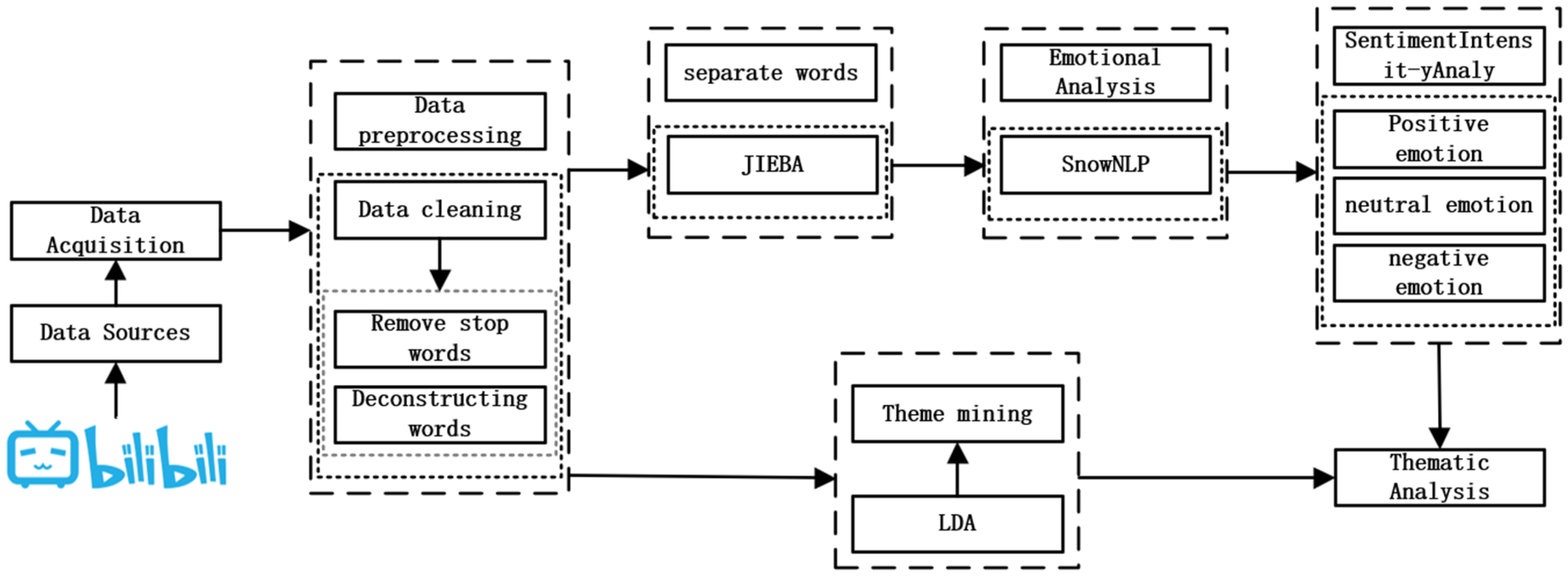
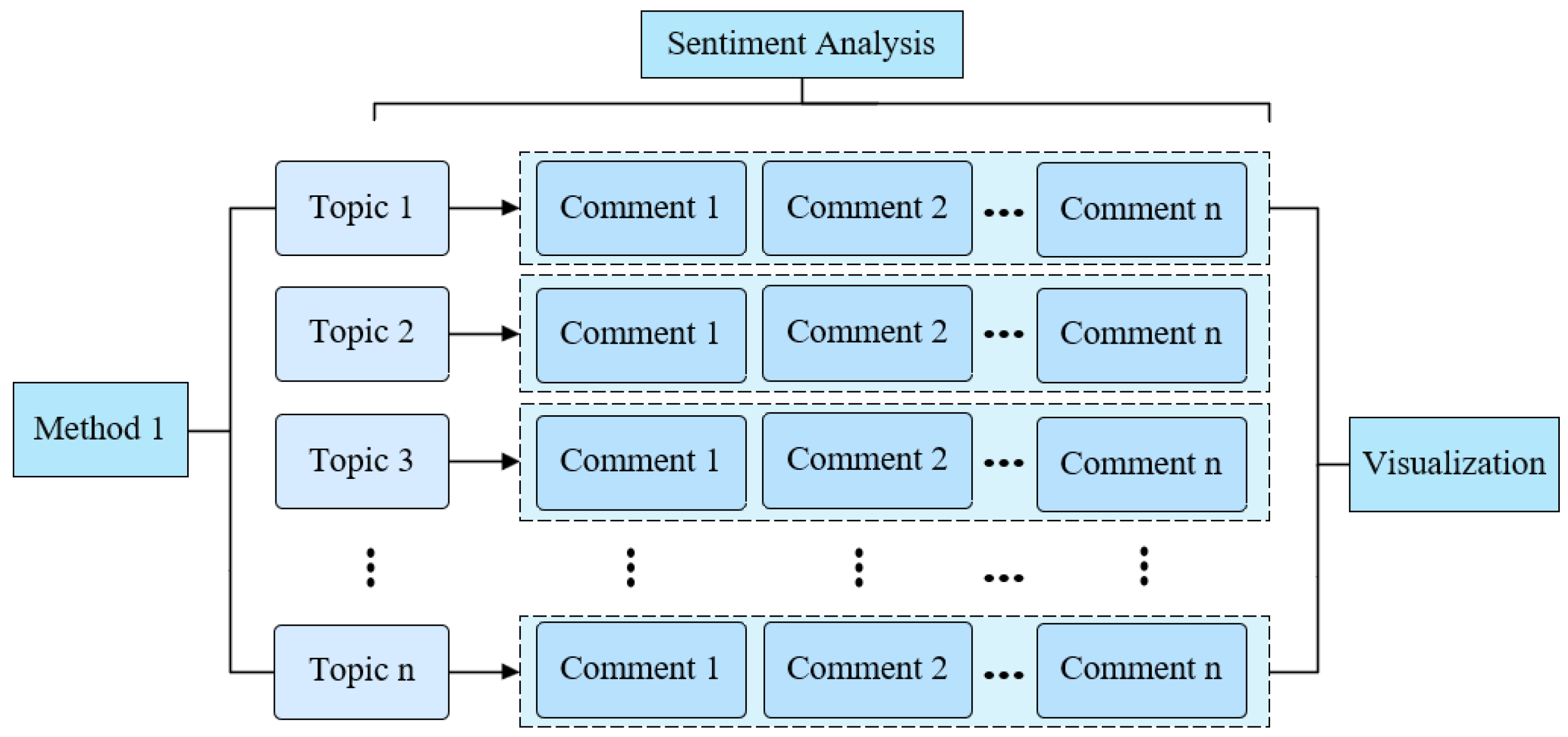
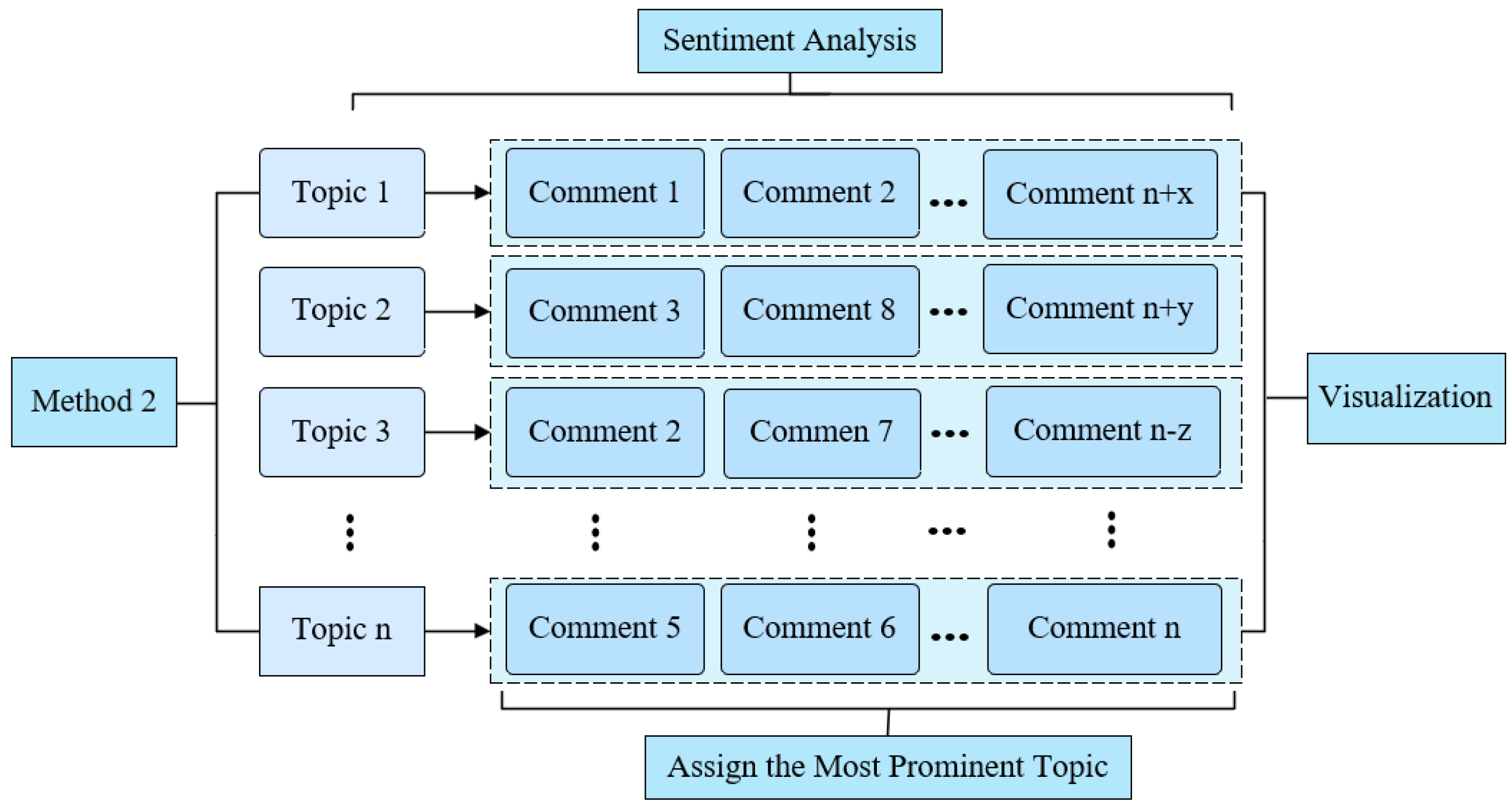
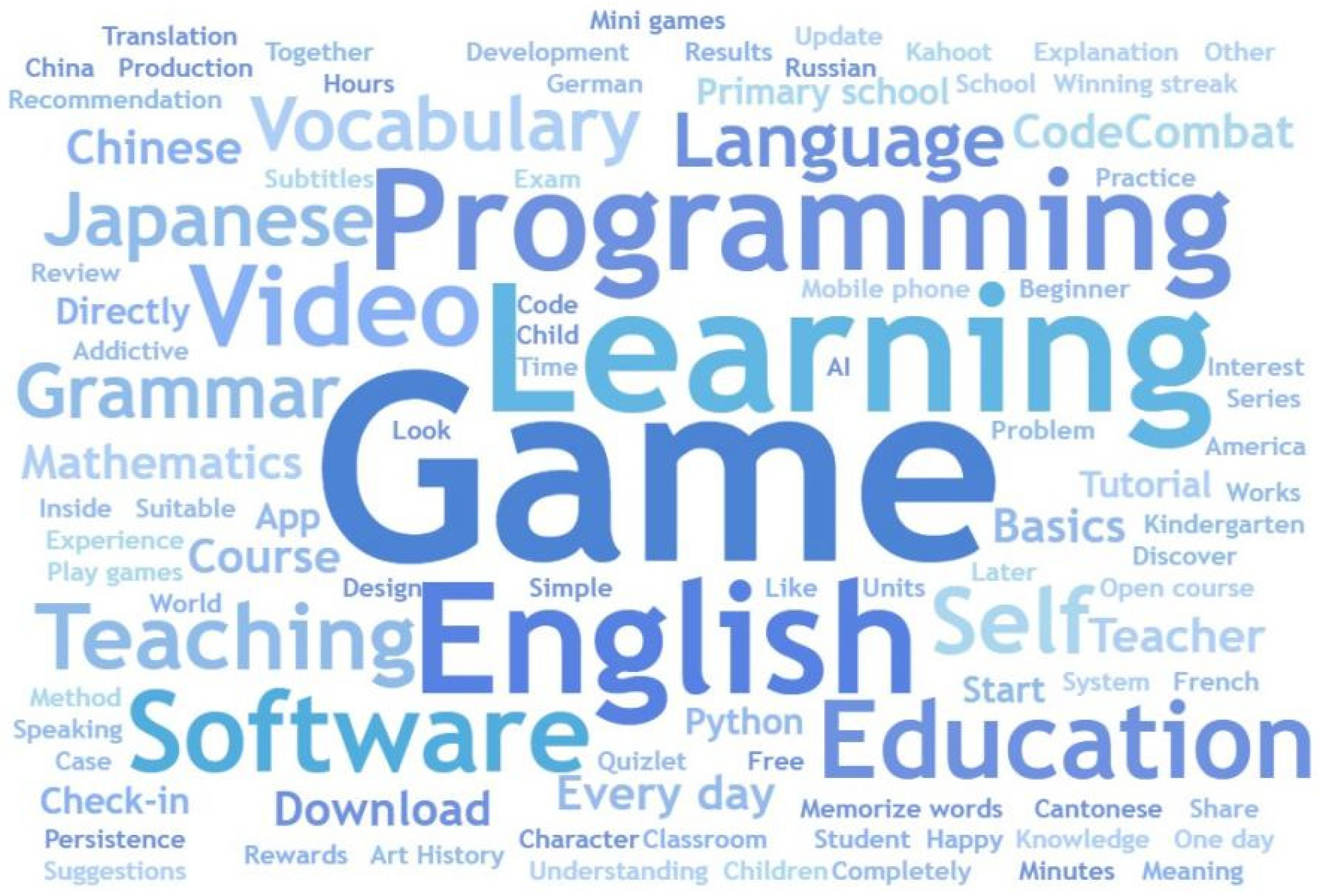
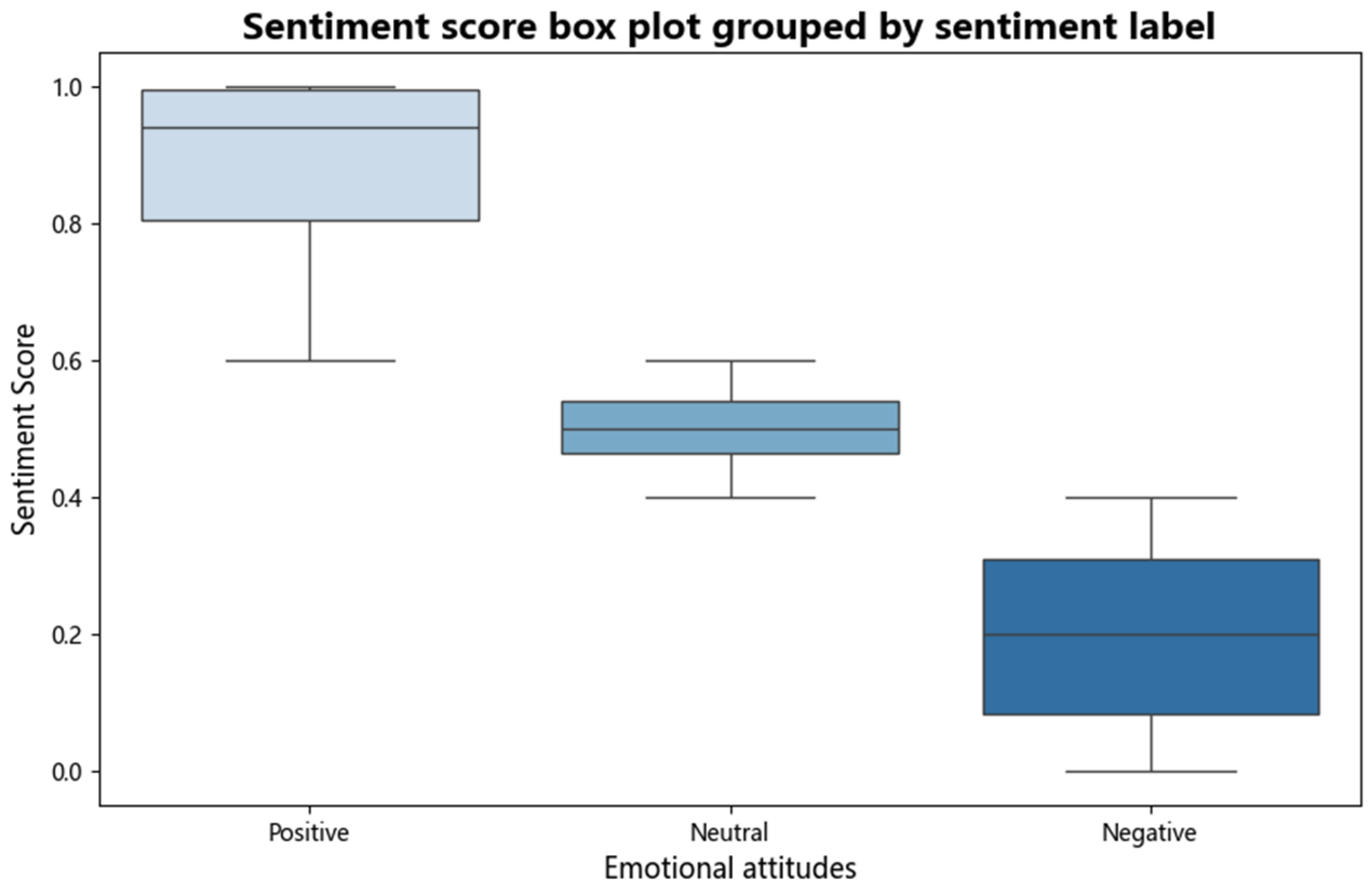
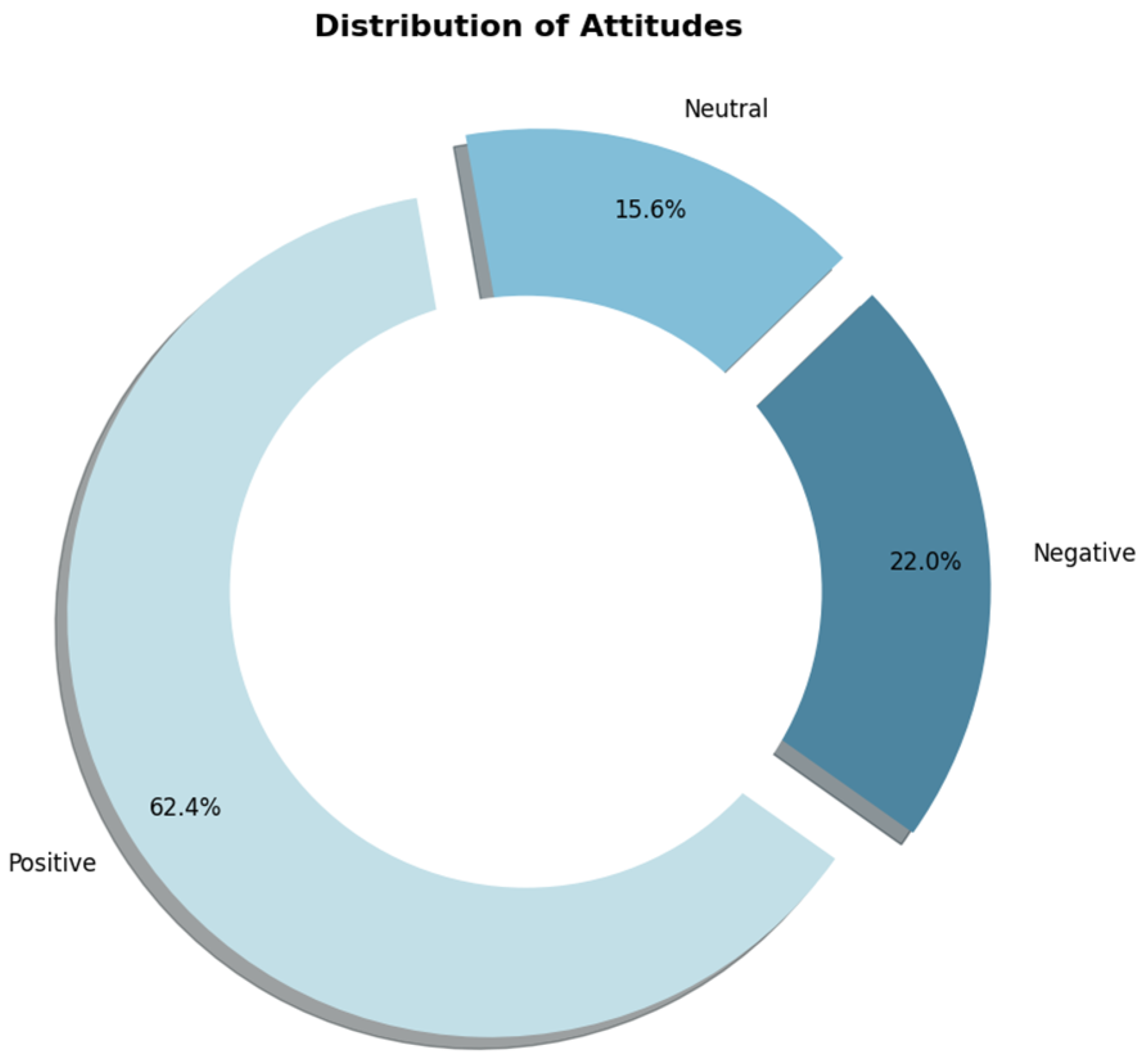
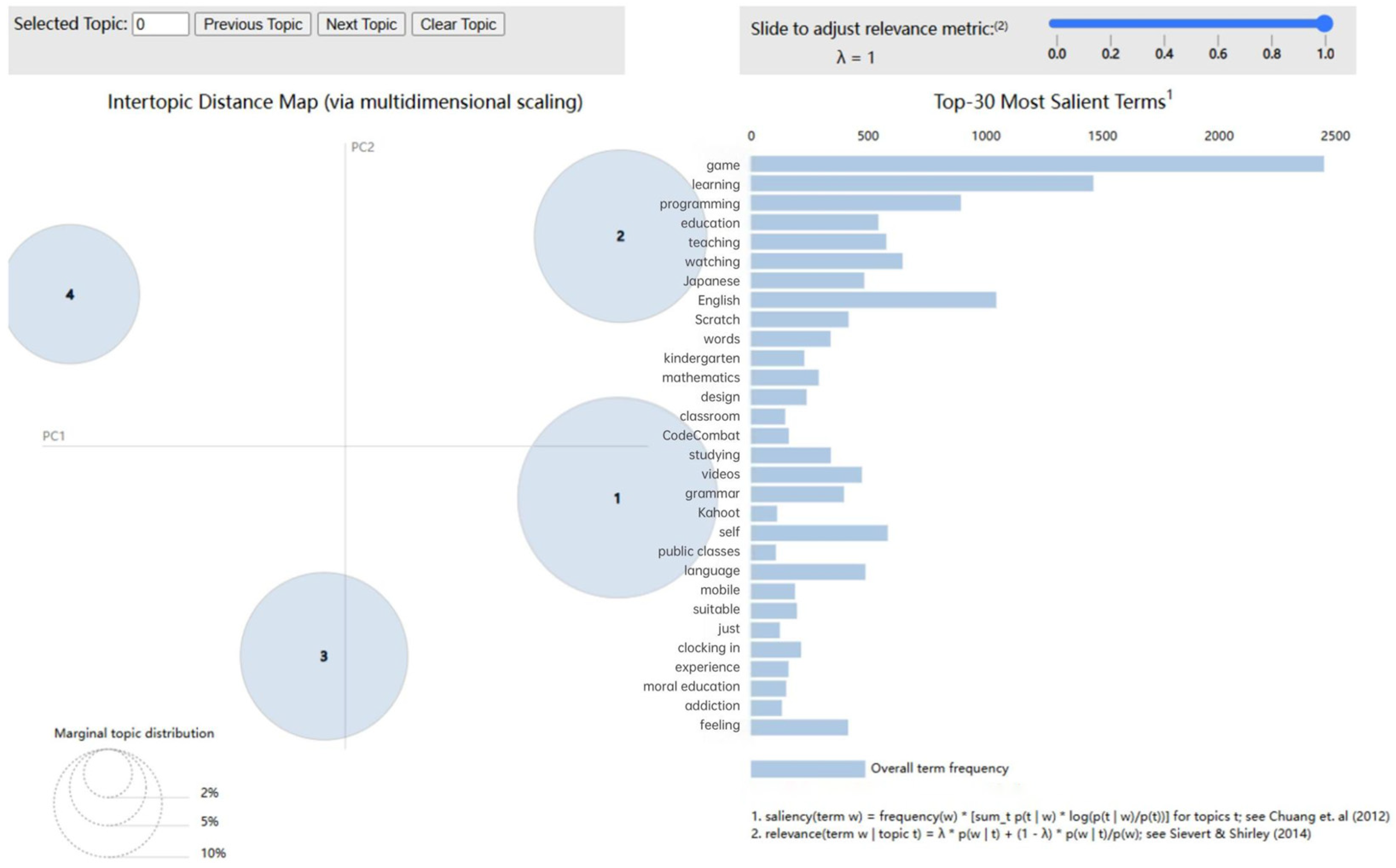

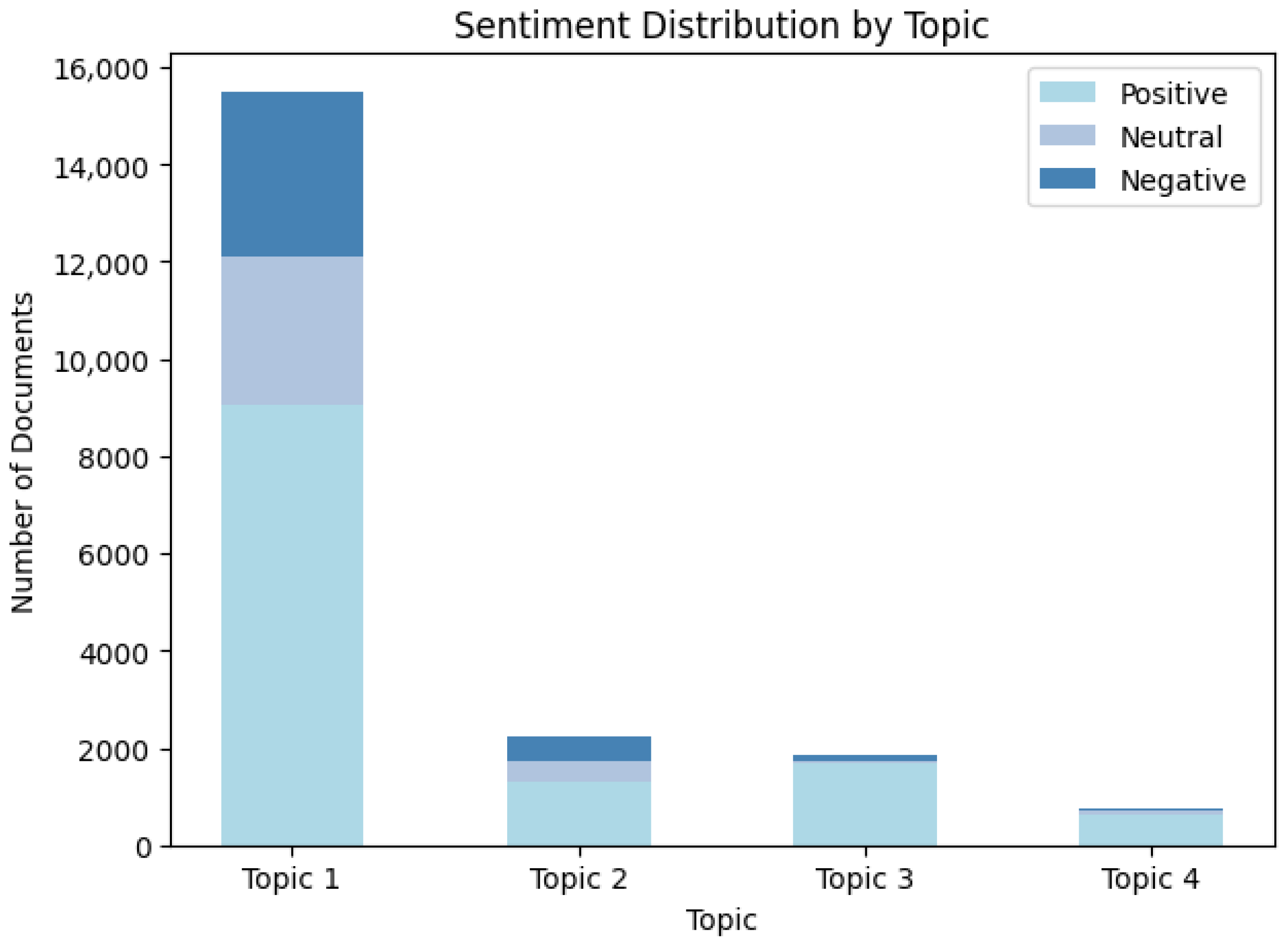

| Group | Accuracy | Precision | Recall | F1 Score |
|---|---|---|---|---|
| 1 | 0.71 | 0.68 | 0.74 | 0.71 |
| 2 | 0.73 | 0.70 | 0.75 | 0.73 |
| 3 | 0.75 | 0.73 | 0.77 | 0.75 |
| 4 | 0.72 | 0.69 | 0.72 | 0.71 |
| 5 | 0.73 | 0.70 | 0.75 | 0.73 |
| Num | Word | Frequency |
|---|---|---|
| 1 | game | 1956 |
| 2 | learn | 1442 |
| 3 | English | 1116 |
| 4 | programme | 881 |
| 5 | video | 649 |
| 6 | software | 568 |
| 7 | oneself | 557 |
| 8 | education | 471 |
| 9 | teach school | 465 |
| 10 | Japanese | 459 |
Disclaimer/Publisher’s Note: The statements, opinions and data contained in all publications are solely those of the individual author(s) and contributor(s) and not of MDPI and/or the editor(s). MDPI and/or the editor(s) disclaim responsibility for any injury to people or property resulting from any ideas, methods, instructions or products referred to in the content. |
© 2025 by the authors. Licensee MDPI, Basel, Switzerland. This article is an open access article distributed under the terms and conditions of the Creative Commons Attribution (CC BY) license (https://creativecommons.org/licenses/by/4.0/).
Share and Cite
Ding, L.; Zhang, H.; Zhou, J.; Chen, B. Contextualization, Procedural Logic, and Active Construction: A Cognitive Scaffolding Model for Topic Sentiment Analysis in Game-Based Learning. Behav. Sci. 2025, 15, 1327. https://doi.org/10.3390/bs15101327
Ding L, Zhang H, Zhou J, Chen B. Contextualization, Procedural Logic, and Active Construction: A Cognitive Scaffolding Model for Topic Sentiment Analysis in Game-Based Learning. Behavioral Sciences. 2025; 15(10):1327. https://doi.org/10.3390/bs15101327
Chicago/Turabian StyleDing, Liwei, Hongfeng Zhang, Jinqiao Zhou, and Bowen Chen. 2025. "Contextualization, Procedural Logic, and Active Construction: A Cognitive Scaffolding Model for Topic Sentiment Analysis in Game-Based Learning" Behavioral Sciences 15, no. 10: 1327. https://doi.org/10.3390/bs15101327
APA StyleDing, L., Zhang, H., Zhou, J., & Chen, B. (2025). Contextualization, Procedural Logic, and Active Construction: A Cognitive Scaffolding Model for Topic Sentiment Analysis in Game-Based Learning. Behavioral Sciences, 15(10), 1327. https://doi.org/10.3390/bs15101327






